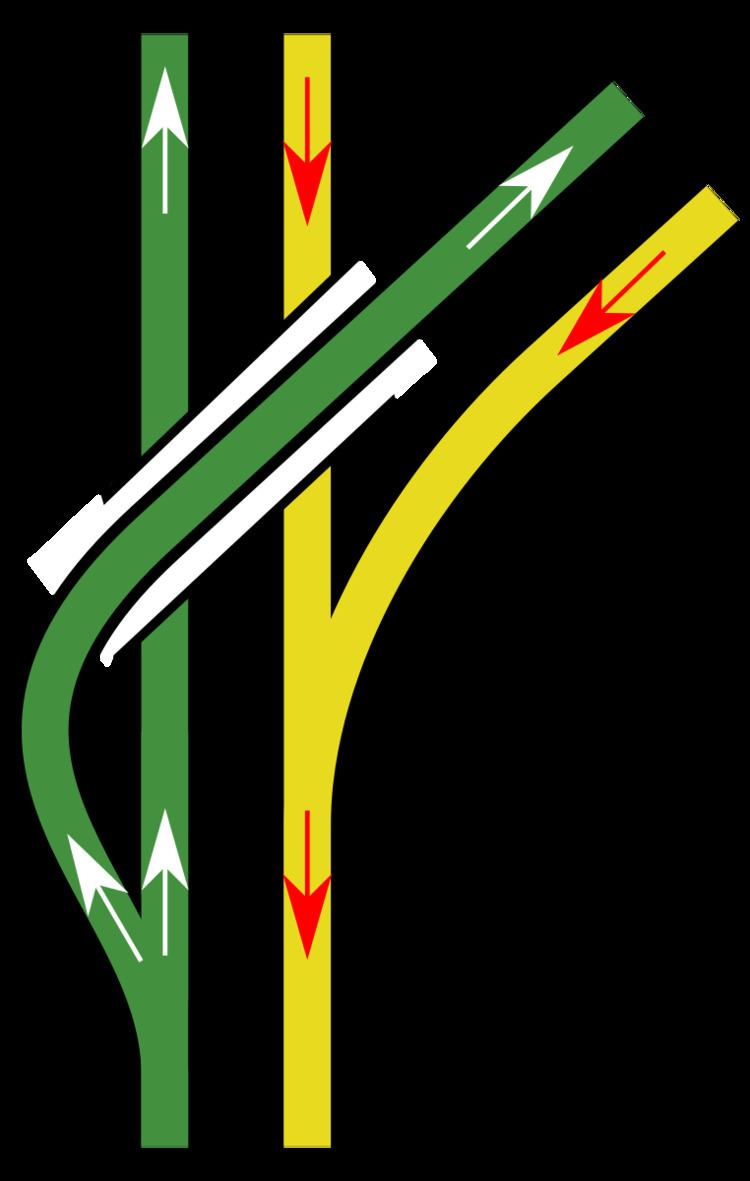A flying junction or flyover is a railway junction at which one or more diverging or converging tracks in a multiple-track route cross other tracks on the route by bridge to avoid conflict with other train movements. A more technical term is "grade-separated junction". A burrowing junction or dive-under occurs where the diverging line passes below the main line.
The alternative to grade separation is a level junction or flat junction, where tracks cross at grade, and conflicting routes must be protected by interlocked signals.
Simple flying junctions may have a single track pass over or under other tracks to avoid conflict, while complex flying junctions may have an elaborate infrastructure to allow multiple routings without trains coming into conflict, in the manner of a highway stack interchange.
Where two lines each of two tracks merge with a flying junction, they can become a four-track railway together. This happens regularly in the Netherlands (see Examples below).
Nearly all junctions with high-speed railways are grade-separated. On the French LGV high-speed network, the principal junction on the LGV Sud-Est, at Pasilly where the line to Dijon diverges, and on the LGV Atlantique at Courtalain where the line to Le Mans diverges, are fully grade separated with special high-speed switches (points in British terminology) that permit the normal line speed of 300 km/h (186 mph) on the main line, and a diverging speed of 220 km/h (137 mph).
The LGV (Lignes à Grande Vitesse) network has four grade-separated high-speed triangles: Fretin (near Lille), Coubert (south-east Paris), Massy (south-west Paris) and Angles (Avignon). A fifth, Vémars (north-east Paris), is grade separated except for a single-track link on the least-used side, linking Paris Gare du Nord and Paris CDG airport.
AustraliaBowen Hills railway station in BrisbaneBurnley railway station in MelbourneCamberwell railway station in MelbourneSydney Central StationSandgate Flyover, Newcastle - main line flies over coal branch lineDenmarkJunction of M1 and M2 lines on the Copenhagen MetroFrance (LGV Triangles)Triangle de Fretin, Lille, connecting Paris, Brussels and London. (map)Triangle de Coubert, Paris. (map)Triangle des Angles, Avignon, with two parallel 1.5 km (0.93 mi) viaducts. (map)Triangle de Massy, Paris, partial four-way junction. (map)Triangle de Vémars, Paris. (map).GermanyBruchsal Rollenberg junctionHong KongWhere Airport Express and Tung Chung Line diverge from each other at Tai Ho WanTseung Kwan O Line to the east of Tseung Kwan O StationNetherlandsThere are between 25 and about 40 flying junctions on Dutch railways, depending on how more complex examples are counted.
near Harmelen. Before conversion to a flying junction, this was the site of the Harmelen train disaster.at Breukelen railway stationat Lage Zwaluwe railway stationFlying junctions where the merged lines become a four track railway:
near Den Haag Laan van NOI railway stationnorth of Leiden where lines from Haarlem and Schiphol mergeat Boxtel railway station where lines from 's-Hertogenbosch and Tilburg mergewest of Gouda where lines from Rotterdam and The Hague mergeMore complex flying junctions, with tracks from four directions joining:
around Amsterdam Sloterdijk railway stationaround Duivendrecht railway stationNorth-west exit of Utrecht Centraal railway stationWest and north-west exit of Rotterdam Centraal railway stationat both sides of Weesp railway station (see diagram at right)United KingdomPelaw Junction where both the Tyne and Wear Metro green line to South Hylton joins the Durham Coast Line and yellow line continues to South Shields - both diverging on the bridge itself (map)Springhead Junction on the North Kent LineSouthfleet Junction on the HS1Norton Bridge Junction near Stone, StaffordshireHamilton Square underground station, Birkenhead, on MerseyrailAynho Junction in Aynho, NorthamptonshireWorting Junction near Basingstoke, Hampshire (the flyover is called Battledown Flyover)Cogload Junction near TauntonWeaver Junction near Dutton, Cheshire (map) - the first everShortlands Junction in south LondonNorth-west of Harrow-on-the-Hill, in the north London suburbsHitchin flyover, north of LondonReading West JunctionBleach Green Viaducts & Junction, Whiteabbey, Northern IrelandTaiwanStart of Shalun Line, south of Zhongzhou StationUnited StatesAn abandoned underground junction on the Tremont Street Subway approaching the Pleasant Street Incline in Boston, MassachusettsThe two southern branches of the MBTA Red Line in Boston split via a flying junction just north of JFK/UMass station. In addition, lead tracks to Cabot Yard maintenance facilities branch off from the junction.on the Broad Street Subway in Philadelphia to un-built spurs on Stenton Avenue, the Roosevelt Boulevard, and Passyunk Avenuealong the New York-Washington section of the Northeast Corridor, and the Philadelphia-Harrisburg section of the Keystone Corridor, converging at Zoo Junction near 30th Street Station in Philadelphia. All were built by the former Pennsylvania Railroad and are now maintained by Amtrak. 39.97086°N 75.19848°W / 39.97086; -75.19848on the New York City Subway at Hammel's Wye on the IND Rockaway Line. (map)connecting Metro-North Railroad's New Haven Line and Harlem Line, near Wakefield station in the Bronxon the Market Street Subway in San Francisco where the J Church and N Judah lines join the main line of the subway. The subway portal is east of the intersection of Church Street and Duboce Avenue in the Duboce Triangle neighborhood, immediately north of a Safeway supermarket and south of the San Francisco branch of the United States Mint.on the Regional Transportation District in Denver between the Southeast Corridor and the I-225 Corridor: the Southeast Corridor is on the west side of I-25 and the I-225 Corridor is in the median of I-225. The grade separations of the junction are woven into the grade separations of the interchange between the two highways. (map)All main-line connections on the Washington Metro - adjacent to the Pepco power plant on Benning Road (near the Stadium-Armory station) is a large three-track structure with a turnback pocket where the Blue, Silver and Orange Lines meet. This would have been part of the Oklahoma Avenue station, had it been built. South of the King Street station in Alexandria is a series of tunnels where the Blue and Yellow Lines meet. There are also flying junctions near three underground rail stations: Rosslyn (Blue, Silver, and Orange Lines), L'Enfant Plaza (Green and Yellow lines), and the Pentagon (Blue and Yellow lines).Bloomfield (NJT station) to eliminate level crossings
